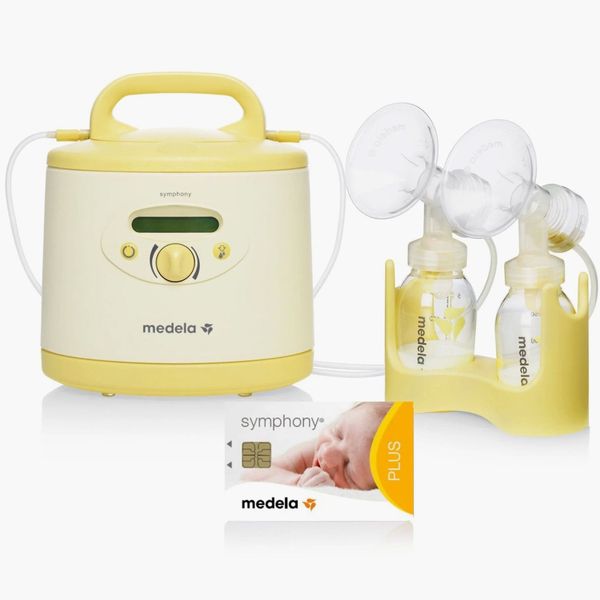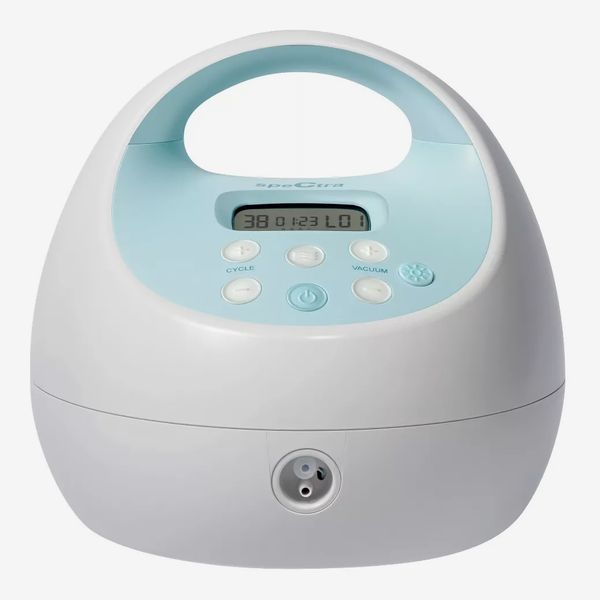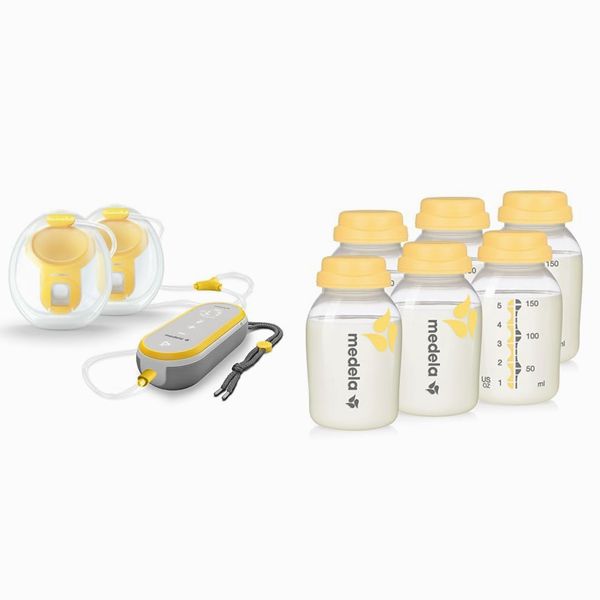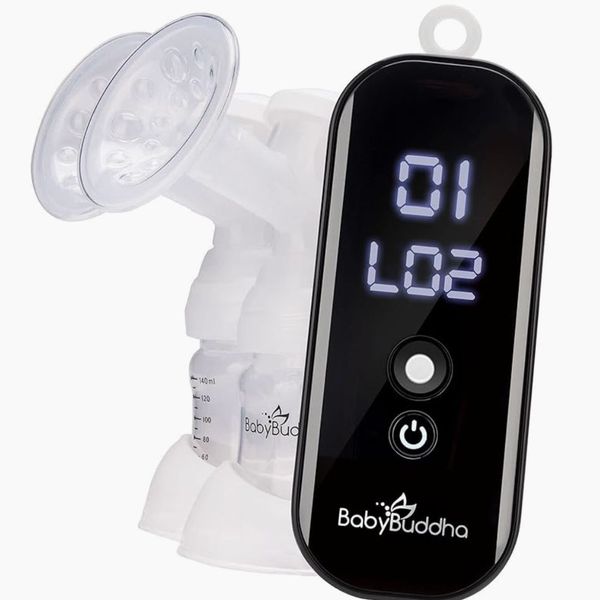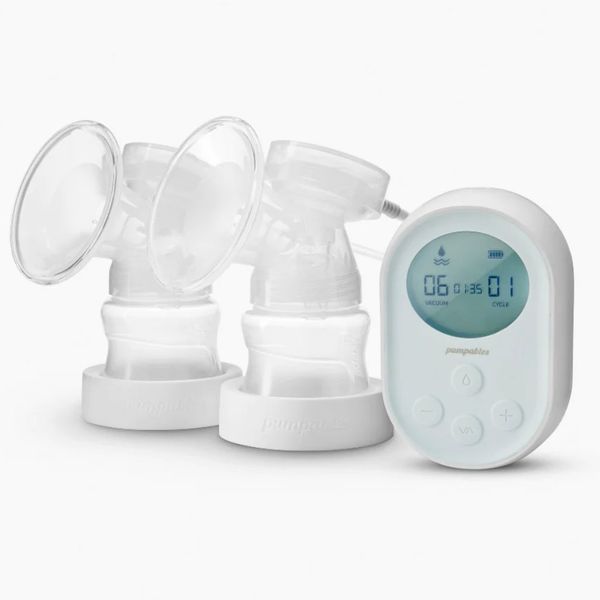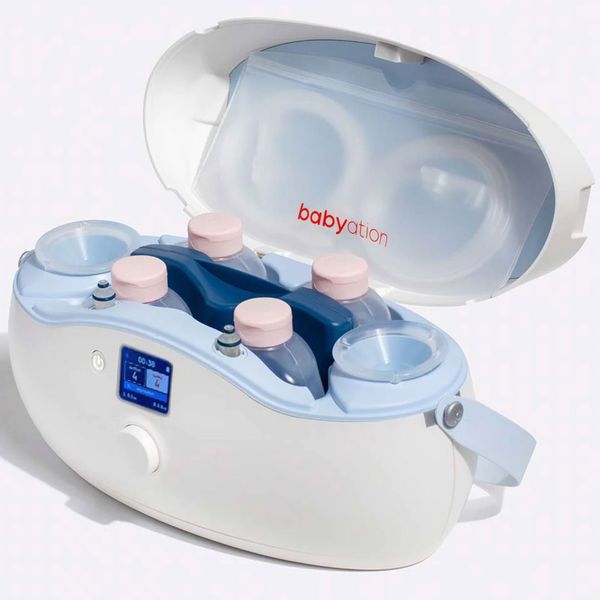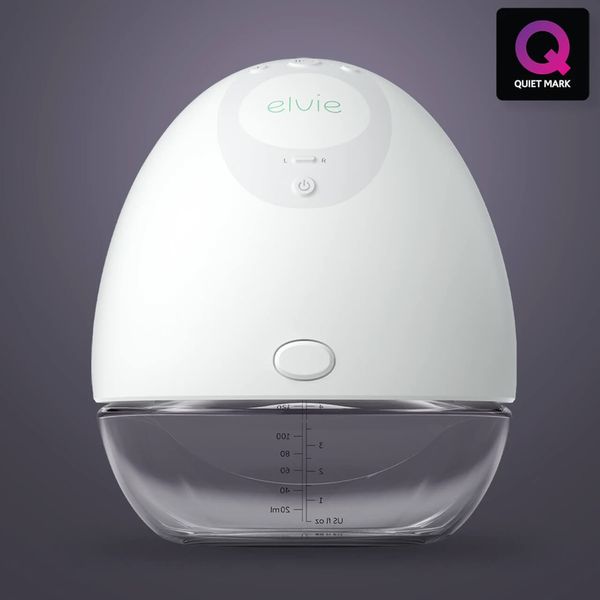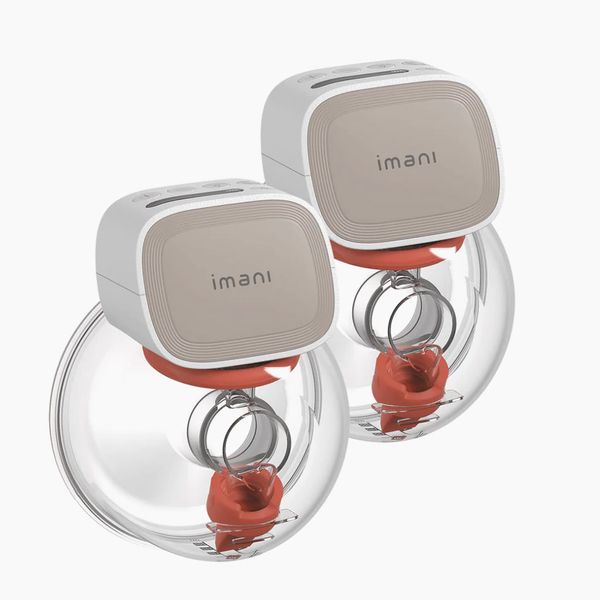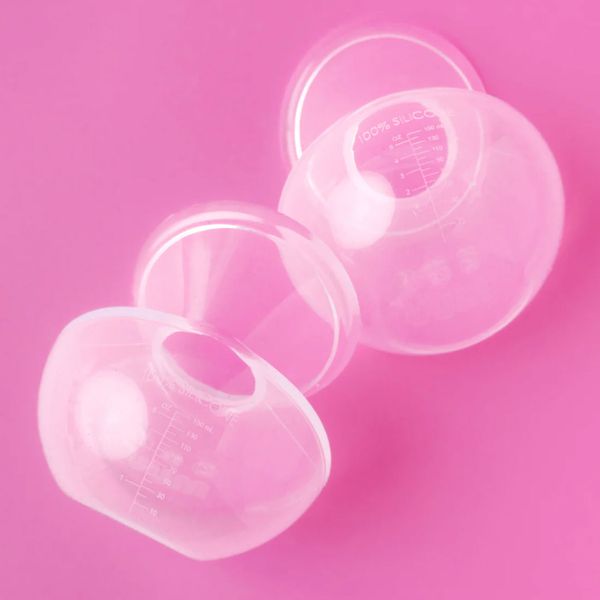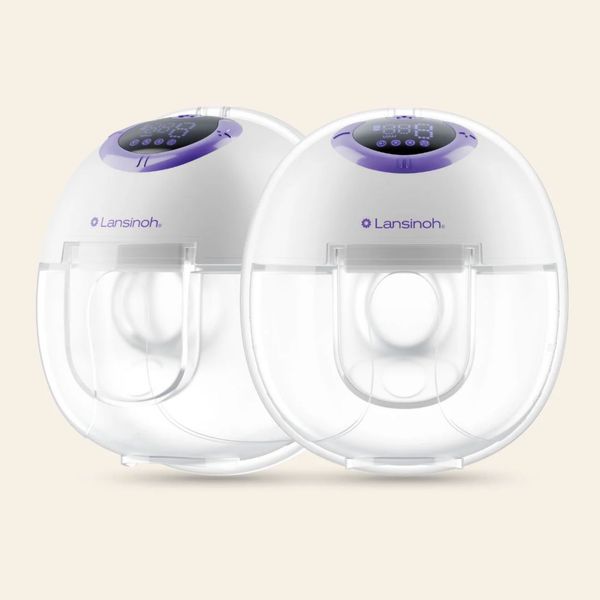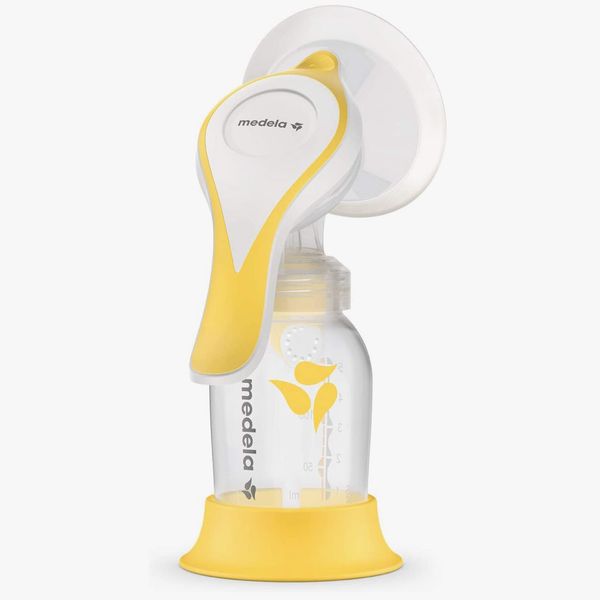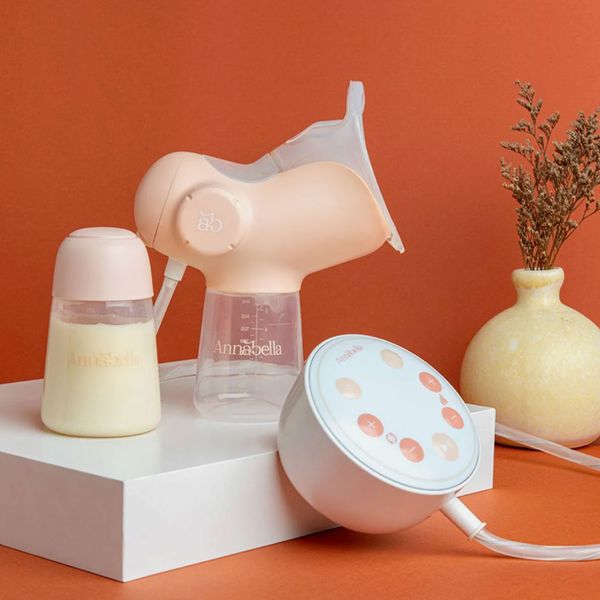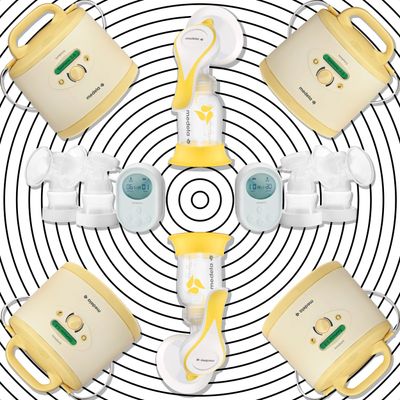
For more of the Cut’s favorite fashion, beauty, and home finds, sign up for the weekly Cut Shop Newsletter.
One of the most daunting aspects of new-motherhood, at least as someone who is pregnant with their first baby, is the whole breastfeeding ordeal. Whenever someone describes what it entails — nursing, latching, pumping, dumping, etc. —I start to picture Russell Crowe’s character in A Beautiful Mind when he’s about to crack the code, except that my lightbulb moment never arrives. I’m so intimidated by the whole thing, but since there’s no going back, the only option is to figure it out. The best place to start? With the most intimidating part: breast pumps, a.k.a. the strange, torture-adjacent devices you would never interact with if it weren’t for the joys of parenting.
“Given a good education, the intention to breastfeed, and the right support, you’re going to make it,” Corky Harvey, RN, MS, founder of the Pump Station, assures me. “Is it easy? Not necessarily. But it’s worth it.”
Here’s everything she and other experts taught me about breast pumps, along with a shortlist of the best to buy among the seemingly endless options.
So, you’re on the hunt for the best breast pumps?
➼ FAQs
➼ Best breast pumps
➼ Our experts
.
Best Breast Pumps
The Best Hospital-Grade Breast Pump
In addition to repeated recommendations for this pump by the Pump Station founder Corky Harvey, RN, MS, many new and veteran mothers also recommended the Medela Symphony as their top pick without qualifications. This pump is a sure bet when it comes to efficient milk release, as it’s been proven to achieve faster letdown and milk flow than other pumps. It can really help in the early days of establishing your milk supply, and it’s especially great for those who are exclusive pumpers or who need a little extra help with their supply even as they get into the swing of pumping. It’s by far the priciest model on this list, but it can be rented from the hospital for a reasonable monthly fee.
The Best Double-Electric Pump and Best Overall
Somewhere around 70 percent of moms I spoke to recommended this breast pump, including Pediatrician Caryn Cassidy, MD, FAAP, at Tenth Street Pediatrics. “It’s the one I use at home, and I find that most of my friends also use it,” she says. “I love it because it’s convenient and easy.” Harvey likewise recommends this pump. “All of us at the Pump Station are Spectra fans,” she says.
The Best Portable Breast Pump
This is Harvey’s top recommendation in the portable category, and she notes that a company which tested over 100 pumps ranked it No. 1. “It’s a really good pump,” she says. It’s powerful enough to be used as a primary pump for busy moms, with output that more or less matches the brand’s Pump in Style, a heftier double-electric, and yet it weighs less than one pound. Its battery lasts for about two hours, and it comes with a USB cable for on-the-go charging. And it’s easy to use with just four buttons and a nice-to-have bluetooth function that allows you to connect with the Medela app in order to control your settings and monitor your output. It’s also easy to wash — the collection cups are made up of just three parts.
The More Affordable Portable Breast Pump
When it comes to portable pumps, social media seems to have a favorite, which Harvey also recommends: The Baby Buddha. “It sucks you dry,” says one high-powered mother-of-two I spoke with. “I hate pumping so much I only want to do it if I’m being maximally efficient.” It’s known for being small — it can literally fit in your pocket — but mighty. It provides an easily customizable experience as well, boasting 14 different suction settings, including a simulation mode with five settings and an expression mode with nine. It can also be used as either a double or single pump, and has a battery life of around one hour. And while it comes with bottles, it can be used with collection cups for more discreet wear. It’s great for exclusive pumpers who want to be able to multitask while they pump or anyone who, like the busy mom I spoke to, just wants to do the most in the least amount of time.
Another Affordable Option
This is another fan-favorite portable, which Dr. Cassidy recommends based on her own experience. “I get good output with it, and it’s easy to move around,” she says. As her review suggests, the Genie Advanced is a powerful and lightweight pump. It is a bit heftier than the Baby Buddha, but its battery lasts longer — three to four hours — and it’s also a bit gentler, suction-wise, according to moms who have tried both. The shield kit that comes with this pump, called The Liquid Kit, is also known for being super comfortable. Overall, this is a great option for a primary pump or for a secondary pump you can easily transport to and from work and other outside-the-home destinations.
The Splurge-worthy Breast Pump
“This pump was way more comfortable than any other pump I had used prior,” says mother-of-two Danielle Finke, who liked the pump so much that she signed on to do PR for the brand. It’s also designed in an innovative way that allows you to pump hands-free without a pumping bra, and unlike other pumps, you can even lie down while pumping. This unique design also means you only have to clean the flanges between uses; however, it also features disposable tubing that cannot be reused and therefore has to be disposed of every 24 hours, leading to ongoing tube purchases.
The Best Wearable Breast Pump
Wearable-pump recommendations can be divisive. When it comes to this one, the moms who loved it really loved it — mainly because it’s discreet, lightweight, and easy-to-use. “I could wear it while doing photoshoots, and the parts to wash were small. It takes a minute to figure out latching, but I loved it,” says mother of two Nicky Deam. This app-connected smart pump monitors your output and automatically stops when you’ve reached five ounces per shell. It also has a new feature, SmartRhythm settings, which allow you to customize your suction and optimize your output, as well as seven intensity settings. The battery lasts for approximately 2.5 hours.
The Best Affordable and Wearable Breast Pump
For a more affordable wearable, Harvey recommends this new version from Imani. “It’s our favorite wearable by a lot,” she says. And while it’s not quite as discreet as some other wearables, she finds that most moms don’t care about the “discreet” aspect of these pumps as much as they do about the “wearable” aspect. It features five stimulation settings and five expression settings, but it will not switch between the two automatically — you have to remember to do it manually mid-pump. It also doesn’t track your output, or how long you’ve been pumping, in any way, so you’ll have to do all the timing work yourself.
The Super Affordable and Wearable Breast Pump
This might just be the least intimidating breast pump on the market. “The Muu is a brand-new pump created by a fellow mom that is simple, affordable and both hands-and-wires free,” says mother of three Amanda Eberstein. “I love to use it while feeding my little one — it’s great for catching excess milk — and it’s also ideal for days when I’m on the go.” It has no motor and is not electric; instead, it relies on natural suction that you can think of more like the steady suck of a passive pumping session versus the full-force suckle of a motorized pump. The suction level is, however, manually adjustable by squeezing more or less air out of the bulb before attaching it to the breast — the more air you squeeze, the more intense the suction.
The Fully-Covered-by-Insurance Wearable Breast Pump
This wearable offering from trusted pump brand Lansinoh is brand new as of January, at which time it was made available through insurance only. It is now available to all moms for purchase, but it also remains available through insurance as the only wearable pump you can get without paying an out-of-pocket upgrade fee. Since Medicaid recipients aren’t eligible for out-of-pocket upgrades, this is the first wearable pump available to those individuals through insurance. It’s lightweight, discreet, easy to use, and powerful, with four pumping modes and nine levels of suction. And while this is not a smart pump, it does track your pumping and will shut off after 20 minutes; however, it doesn’t tell you how much milk you’ve pumped or otherwise provide real-time feedback. Moms report that it’s fairly intuitive to use, relatively quiet, and easy to clean, and that it’s also easy to transfer milk from this pump without spilling.
The Best Manual Breast Pump
Though she does say she rarely sees moms use manual pumps, Harvey puts this one at the top of her list for the category. It features a simple, no-frills design that makes it easy to transport and use for times when you’ll be away from your baby for a few hours or need to just relieve a bit of pressure from your breasts. Thanks to technology incorporated into the handle, you can manually switch between stimulation and expression suction modes. As a nice bonus, it’s designed with a swiveling handle so that you can switch hand positions as often as needed during a pumping session. “It’s easy to travel with and allowed me to pump anywhere,” says mother-of-two Margie Stein. “I often felt like I was able to pump more milk with this hand pump than with my electric pump. Plus it kind of felt like I was getting an arm workout!”
The Most Comfortable Breast Pump
The Annabella is a new pump that’s been seven years in the making. Unsatisfied with what she saw as antiquated “vacuum”-pump technology, founder Masha Walberg set out to create something that operated more naturally. The result is the Annabella, which incorporates technology designed to simulate the unique motion of a breastfeeding baby’s tongue for optimized milk production. “The actual pumping part feels so much nicer (more like a baby’s tongue) than a regular pump,” says new mom Leah-Vail Soloff. “The flange also feels amazing, so soft and easy to pull over the nipple.” This innovative pump features a knob that can manually adjust the size of the breast shield or flange, which is a super-helpful way for mothers to find their best fit initially and also to easily adjust the fit over time without having to buy and try out different size breast shields. The downside to this pump is that it’s a single pump rather than a double. “It took 30 minutes and yielded less milk than a ten-to-15 minute Spectra session where I can wear both pumps at the same time,” says Soloff. “But I hate pumping during the day, and when I have to do it I think this is a super easy way to get in a low-pain pump session.” Walberg says the double-pump version is coming soon.
.
FAQs
When am I going to use a breast pump?
The short answer is “It depends.” Some moms never or rarely pump, and some exclusively pump. Many are somewhere in between.
Exclusive pumping usually takes place when there are issues with nursing directly, such as difficulty latching. It can also be a matter of preference. Caryn Cassidy, MD, FAAP, at Tenth Street Pediatrics, says she knows moms who prefer to exclusively pump because they feel it’s more efficient. On the flipside, Morgan Dixon, lactation consultant, says that one message she likes to make sure gets communicated to her clients is that you don’t have to pump, or that you can very rarely pump, if you don’t want or need to based on your ability to be near your baby most of the time.
Many moms begin pumping some percentage of the time in order to gain a bit of independence from their baby, often for the purposes of returning to work. If you fall into this category, Harvey says it’s important to start pumping when your baby is two to four weeks old and give them the bottle around three times per week and no more than once a day — even if you’re not going back to work for several months. If you don’t do this, she says, your baby may refuse the bottle when you urgently need them to be able to take it.
If you’re uncertain as to when to incorporate pumping into your routine, Harvey recommends seeking advice from a lactation consultant who can provide personalized guidance.
What are the different types of breast pumps?
“The choice depends on your lifestyle, pumping needs, and personal preference,” says Jada Shapiro, lactation consultant and founder of Boober. Your pump preference may change over the course of your breastfeeding journey, too. Here is a breakdown of each type, along with when it’s most likely to be useful:
Hospital-grade: “It is usually recommended for a mother with a hospitalized baby in the NICU, a mother with twins, a mother with a low milk supply, or a mother with a history that would put her at risk of a low supply (for example, if she’s had breast surgery),” says Harvey. “Hospital-grade pumps, like the Medela Symphony, are also the best for establishing, building and maintaining milk supply.” This is the only type of pump that can be used by multiple mothers, says Harvey, as it’s guaranteed against cross-contamination. Hospital-grade pumps are pricey, but can be rented from the hospital after delivery for a reasonable fee.
Double-electric: This is your second-best bet for a go-to, reliable pump. “Double-electric breast pumps are designed for frequent use, allowing people to pump both breasts simultaneously, which is efficient and can help increase milk supply,” says Shapiro. Like a hospital-grade pump, these pumps are also powered by a motor, which is either rechargeable and runs off batteries, or needs to be plugged into an outlet in order to work.
Single-electric: These pumps are identical to double-electric pumps except that they include just one pump, so you will only be able to express milk from one breast at a time. “Single electric pumps offer more portability and convenience, making them ideal for occasional use or pumping on the go,” says Shapiro.
Portable: Portable pumps are pumps with motors that run off batteries and are more lightweight than double-electric pumps. They will typically include a pump motor that’s often small enough to fit into your pocket, with tubing that connects to flange kits you can insert into a pumping bra for a hands-free experience. They tend to be popular with moms given their portability, fairly reliable output, and relative ease of use.
Wearable: Wearable pumps are those that are completely wireless and can fit inside your bra for hands-free, relatively discreet use. These are great for on-the-go use, especially if you need to pump through a Zoom meeting, in the office, or out to dinner. They do tend to be less powerful than other pump types, however, so Harvey does not recommend planning to use them as a primary pump.
Manual: Manual breast pumps rely on hand-operated suction rather than a motor and as a result, they are lightweight and easy to transport. These pumps “are perfect for people who pump infrequently or need a quiet and compact option and don’t want to be bogged down by a cord,” says Shapiro.
Silicone: This final type of pump hangs off the breast, using natural suction that is constant and does not suck and release to extract milk. This type of pump is to be used sparingly. Harvey says most mothers utilize this pump while they’re nursing.
How do you know which type of breast pump might be right for you?
Breast-pump use is very personal, and while there are some “safe” choices, such as a double-electric pump, women tend to have not only different needs but different experiences with each type of pump. This may result in some trial-and-error, but generally speaking, Shapiro says that you should consider the following factors when shopping for a pump: frequency of use, portability and convenience, power source, comfort and fit, ease of cleaning, noise level, cost and insurance coverage, whether you need to run around while pumping, and any special features that may suit your lifestyle and nursing goals.
What features should you look for in a breast pump?
Often, pumps will offer a range, which varies from pump to pump, of suction and speed or intensity settings, which can be great tools for customizing your feeding sessions according to your output needs and preferences. Some new pumps, says Harvey, even allow you to customize settings for each breast.
And pumps do need to have at least two different settings. The first is often called stimulation mode, and the second is often referred to as expression mode.
“Pumps will often start with a quick let-down phase that usually lasts about two minutes, and this is usually a faster-speed pump,” says Dixon. This mimics the way a baby initially feeds — it’s called “non-nutritive sucking,” says Harvey — and it stimulates hormones that trigger the release of milk. “Then it’ll switch over to a long, drawn out suction pump for expression,” Dixon says. “That’s when it’s great to have multiple suction settings, which just depends on preference — the higher you set it, the stronger the suction will be.”
Do breast pumps come in different sizes?
While breast pumps themselves do not come in different sizes, crucial breast pump parts called flanges, or breast shields, do come in different sizes, and finding the right fit for you is critical for optimizing milk output and comfort. “There are measuring tools; however, we recommend starting with the flange that comes with your pump and then buying one size smaller as well,” says Harvey. “Most pumps come with 24-millimeter flanges, and Medela did a study which suggests that about 95 percent of women are 21s to 24s.”
What other accessories do you need with a breast pump?
Most of the parts you need will come in “the kit” included with your pump, including flanges (a.k.a. breast shields), bottles, connectors, valves, and membranes. Beyond that, you should look to purchase or register for the following:
Additional flanges in different sizes: At least one additional, smaller flange than the one that comes with your pump is what’s recommended by Harvey.
Spare parts: Harvey also recommends investing in a few spare parts from your pump kit in order to save time with the washing if you’re very busy or working.
A pumping bra: Some pumping bras can be used to nurse and pump, so you can nurse on one side and pump on the other, and others can just be used to pump, says Harvey. Both enable you to pump hands-free.
Nipple cream: This is used to lubricate the flange opening, says Harvey, and to moisturize and heal dry, cracked nipples in the early months of nursing.
Milk-storage bags: Pumped milk is stored in these bags, usually in the freezer. Some pumps allow you to pump directly into these bags, while with others you will have to transfer from the bottle or collection cup.
Collection cups: According to Dixon, these are “the best thing ever,” and Harvey agrees. They can be placed inside your bra to capture and save leaking milk. They shouldn’t have any suction as they are just meant to serve only as milk receptacles. Harvey’s favorite collection cups are made by Lacticups. You should not, says Harvey, wear them to bed.
Breast-milk chiller: This is more of a nice-to-have than a need-to-have, but Cassidy swears by it. It’s basically a water bottle made just for breast milk that includes an ice pack that keeps the milk chilled. This allows you to leave the milk unrefrigerated for hours if necessary. Mila’s Keeper offers a chic yet functional option.
Saline spray: Dixon says it’s a good idea to invest in a saline spray as well. “It’s amazing to have on hand just to refresh your nipples and make sure they’re moist for breastfeeding and pumping,” she says. “This will help to ensure they don’t blister or crack.”
Nursing Pads: These won’t collect milk, but they will prevent you from leaking through your bra and shirt when you’re out in public or at work.
How will you know if you’ve picked the wrong breast pump?
There are only two main criteria to consider. One is that your pump is comfortable. “If your pump hurts, it’s not the right pump. Pain in the early days can be normal because you’re getting used to something new, but any sustained pain that’s making you not enjoy breastfeeding shouldn’t be happening,” Harvey says.
The problem may be that you have the suction setting turned up too high, or that the flanges don’t fit properly, etcetera. You should reach out to a lactation specialist to help you fix it.”
The second criteria to consider is whether or not your pump is effective at removing milk. The ideal amount of milk will vary depending upon the mom, and even the breast, but in general Harvey says you want to feel like your breasts are a little softer after you’re done pumping. If your output seems low, you shouldn’t necessarily assume the problem is you, says Harvey. The culprit could be the type of breast pump you’re using, e.g. a wearable versus a double-electric, or an ill fit.
Breast pumps are expensive! How can I afford one, let alone more than one?
The Affordable Care Act requires that most insurance plans cover one breast pump, says Shapiro. Double-electric pumps like the Spectra S1 are typically covered under these policies, but it’s best to check with your provider for specifics. With respect to a second pump, you may be able to use Flexible Spending or Health Savings Accounts for tax-free purchases, she says. “Additionally, many new parents create a registry for care and services where you can include a fund for a special breast pump or an additional pump if it’s not covered by insurance,” Shaprio says.
Harvey also offers a hack for moms looking to supplement their reliable double-electric with a pricier wearable. She says that if your insurance is willing to pay for the wearable, then you may want to get that one for free, since it’s more expensive, and then purchase or register for the double-electric pump, which tends to be more affordable. And while it can be tempting to buy a used pump, Harvey does not recommend this as the only type of pump safely made for use by multiple women is a hospital-grade pump like the Medela Symphony.
.
Our experts:
- Caryn Cassidy, MD, FAAP at Tenth Street Pediatrics
- Morgan Dixon, lactation consultant
- Corky Harvey, RN, MS, founder of The Pump Station
